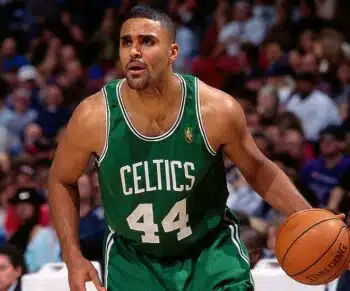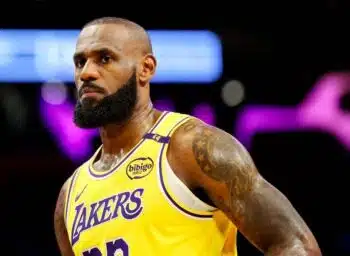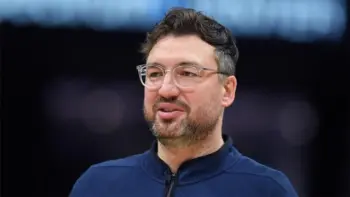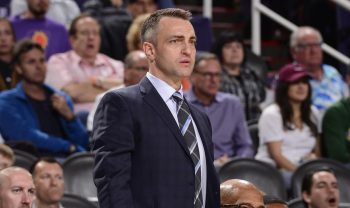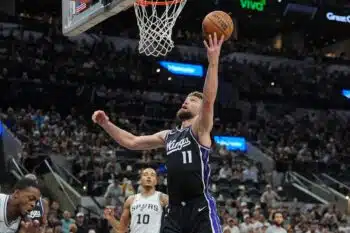NBA
Is The Timberwolves’ Offense Ready For Oklahoma City’s Elite Defense?
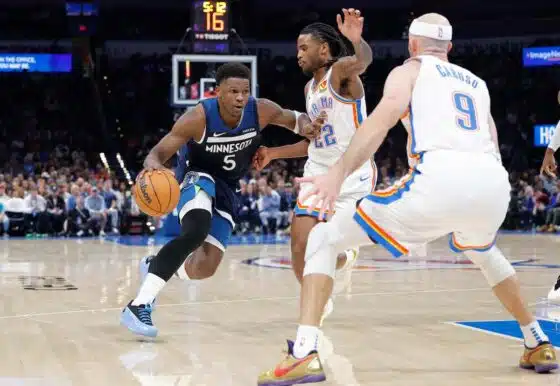
The Minnesota Timberwolves did not have a cakewalk to their second consecutive Western Conference Finals appearance, the first time they’ve accomplished such a feat in franchise history.
But to make their first NBA Finals appearance, they’ll have to defeat a tougher opponent than a Golden State Warriors team missing Stephen Curry and deploying a hobbled Jimmy Butler as their offensive leader. Does their relative injury lucky take away from the accomplishment? No. But does it mean they’ll have a higher bar to clear in their next series, as they battle the limb-storm that is the Oklahoma City Thunder defense? Absolutely.
Anthony Edwards Is Rising To The Moment
Anthony Edwards will have to play the best basketball of his career to defeat the Thunder.
Early in its battle against the Warriors, I wrote about a Minnesota offense struggling to capitalize on the interior. Golden State head coach Steve Kerr’s defense bet against the Timberwolves’ ability to find easy buckets inside and won big. The result was not just turnovers and potential layups gone by the wayside, but low 3-point volume. More concerning than Minnesota’s 17.2 percent shooting from deep in Game 1 was the fact it was only able to get up 29 looks total.
Unsurprisingly, Golden State showed early help against Edwards any time he drove the ball to the paint, particularly when Rudy Gobert, a non-shooter, was on the floor. However, the Warriors could only do this because they didn’t have to worry about interior passes leading to dunks. I explained why in this short video:
Contrast those possessions to this excellent Edwards drive and dime, a lob pass to Gobert for a dunk:
Love this pass from Anthony Edwards. Jonathan Kuminga, the low man, is on Rudy Gobert’s hip, but that doesn’t dissuade Ant from throwing it to the rim: pic.twitter.com/dIGenPtyMZ
— Lucas Kaplan (@LucasKaplan_) May 17, 2025
Jonathan Kuminga is actually in the right position here, according to Golden State’s scheme. He is on Gobert’s hip, theoretically taking away Gobert’s presence at the rim. As soon as Edwards leaves his feet, Kuminga is bailing to the corner, and yes, if Edwards had thrown it there, as he often did in Games 1 and 2, it’d be an easy closeout.
But he doesn’t. Edwards isn’t phased by Kuminga’s faux-help, and it’s a dunk. A mighty fine interior pass.
Per Cleaning the Glass, 48 percent of the Timberwolves’ field goal attempts in Game 5 came directly at the rim, where they shot 31-of-37. In Game 1, they shot just 17-of-32 at the rim. Certainly, some luck was involved, but Golden State was rarely out of position; Draymond Green & Co. were there to contest every look, much different than what we saw at the end of the series.
Edwards slowed his pace throughout the series, allowing him to navigate serious traffic. Is this ideal spacing, with Gobert rolling toward one side of the paint and Jaden McDaniels on the other side? Eh.
Ant, Man: pic.twitter.com/AqjaJbCNfg
— Lucas Kaplan (@LucasKaplan_) May 17, 2025
But because Edwards keeps his dribble alive and the defender on his back, it becomes ideal spacing. The Warriors trust Green to defend any 2-on-1 situation, and they should. But Edwards is at the restricted area by the time Green makes the space. That’s too much pressure for any single defender to deal with.
I’ll be keyed on how stable and patient Edwards’ drives are early in the Western Conference Finals. Plays like the above, or this one, where he keeps his defender in jail and never has to change direction…
Ant’s drives were much better and calmer in Game 2, here holding the defender on his back and forcing Jimmy Butler to sink further into the paint: pic.twitter.com/xvPHVF7KFM
— Lucas Kaplan (@LucasKaplan_) May 10, 2025
…are paramount. Oklahoma City’s defense feasts on out-of-control drives. Its help defenders use any change of direction — say, a spin move or a crossover back to the middle — to wreak havoc.
On these plays, Deni Avdija gets ahead of his feet and misses an open interior pass before Keldon Johnson spins back middle and predictably gets ripped:
Both Edwards and the Wolves collectively improved their floor game as the Golden State series wore on, but the margin for error is still slim. They turned it over 21 times even in their Game 5 victory, and in the regular season, they ranked 18th in turnover rate. Each of the three remaining conference finalists finished among the top six.
They will not morph into better passers overnight, and Gobert will drop a few catchable passes in this series, such is life. But Edwards (and his teammates) can make life easier on themselves before the ball leaves their hands.
East To West Offense
Rarely can a player dribble from the perimeter all the way to the rim against the Thunder — not from a standstill, at least. Minnesota learned this lesson the hard way in its first visit to Oklahoma City in December, turning it over 24 times, including eight during a little-league third quarter:
What do all of those turnovers have in common? They all happen at the top of the key and only one begins with an attempted pass. Minnesota will not be able to simply run a pick-and-roll or an isolation possession for its best players and expect to generate shots at the rim immediately.
In Game 5 against Golden State, the Timberwolves acted upon this philosophy. Yes, Edwards was fantastic creating from a standstill. But this didn’t comprise the majority of their offense; instead, they got plenty of looks at the rim after having broken the defensive shell. For example, the Wolves created advantages for their deadliest off-ball shooter, Donte DiVincenzo, who then cashed in by making the right reads:
Golden State can’t “plan” its help here because there are no driving lanes to load. They Warriors are able to take away the initial shot for DiVincenzo but further rotations behind the ball are lacking. Same thing on this play below, where an Edwards drive is defended well but McDaniels immediately touches the other side of the paint upon receiving the ball:
critical sign for MIN: ball gets to the “third” side of the floor pic.twitter.com/f9GF4siZCF
— Lucas Kaplan (@LucasKaplan_) May 17, 2025
Neither paint touch is particularly explosive, but they happen in quick succession and Golden State’s shell is broken. It doesn’t end in a rim attempt but it’s wide open 3-pointer on the “third” side of the court — literally, the ball has gone from side-to-side-to-side.
Part of that is McDaniels cutting into Edwards’ view, an area the Wolves would do well to emphasize more. It can’t all be drive-kick, drive-kick if they want to create layups; they also have to create rim pressure off the ball. While their cutting is still uneven, it improved throughout the Western Conference Semifinals. (Are you sensing a theme?)
In the first two clips here, the slow-footed Quinten Post is responsible for zoning up two Wolves on the weak-side. On both sequences, neither player cuts to the rim, eliminating the possibility of an easy two points. However, in the third clip, McDaniels is quick to cut behind Green and it’s a lob dunk, proving it’s less about who the help defender is and more about the timeliness of the cuts:
There are plenty of ways to create rim pressure in the NBA. During the playoffs, a team needs to use all of them. Simply lining the best player up at the top of the key and asking him to create may not be easy to defend, but it’s at least predictable.
The more the Wolves move themselves and the ball around and the more methodical Edwards is on his drives, the less predictable they are. The same goes for Randle — who deserves praise here after averaging 25-7-7 against Golden State — and the speed of his decision-making. He can move many of his matchups with brute force but as soon as help comes, the ball has to be out of his hands.
These are a lot of tasks to handle for head coach Chris Finch, who can only do so much, and his players. Yet, the Timberwolves have shown game-to-game offensive improvement throughout the playoffs. They’ve passed all the quizzes so far.
Here comes the biggest test yet.
